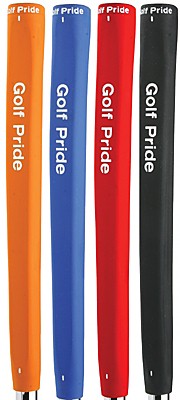Have you looked at your putter grip lately? Is it hopelessly grimy? Has it lost its tackiness? Has it been baked into a hard husk? If so, you need to deal with it, and it’s not as hard as you might think.
First off, let’s look at why you need to deal with it. As Golf Pride, a leading grip manufacturer, puts it, “Putter grips are the most touched, most used, and most overlooked piece of equipment in the bag. Because putter grips are used once, twice, and unfortunately sometimes three or four times per green, they deserve far more attention and care than they typically get.”
Or how about Dave Stockton in his book Unconscious Putting: “Most players understand that they need to change the grips on their irons and woods, but they keep the grip on their putter for way too long…The sweat and dirt on your hands breaks down the putting grip over time and makes it slick. When the grip loses that tackiness, you tend to subconsciously hold it a little tighter, producing tension. Spend the five or ten bucks for a fresh one every six months, at least. It’s worth it.”
So now you’ve seen the light and are ready to ditch your old, worn-out grip. Now what? Well, you’re in luck, because your choices in grips have never been more plentiful. Golf Pride, Iomic, Lamkin, Winn and SuperStroke are among the many providers offering an array of grip styles, sizes and shapes. Best of all, a qualified retailer or club fitter can easily change your putter grip for a nominal cost.
Along the way, don’t assume that the style and size of grip that came with your putter is automatically the right fit for you. You may want to consider changing things up with your replacement grip. For example, if your stroke is wristy and routinely breaks down through impact, it could be a sign that your putter grip is too thin for your hands. If you feel regular tension in the fingers and hands, or if it seems that you are lacking sufficient touch in your putting stroke, you may want to consider a thinner grip.
What you ultimately need to know is that the size of the grip, and how it feels in your hands, can shape your putting performance and make a difference in your score. So give it some thought when you make your switch.
P.S. For a crash course in putter fitting tips that can raise your game, check out our acclaimed putter fitting guide, Putter Perfection.
 PutterZone – Best Putter Reviews
PutterZone – Best Putter Reviews




Simple (scrubby) cleaning with household cleanser and a Scotch Brite will bring most rubber grips back to life. Do it about once every ten rounds or so and the grips will last a looooong time. I’ve got an old broken Ping putter with a rubber grip that I have never seen before. This cleaning trick makes the grip quite sticky and usable.
The caveat with this routine is that grip material that Winn and others are using needs special attention. From the Winn web site: “To clean a Winn grip, apply a small amount of water or rubbing alcohol to a soft towel, and gently rub the grips. Do not saturate the towel. Never use a brush and soapy water to clean a Winn grip because it may damage the top surface and destroy the tackiness and slip-resistance of the grip. Do NOT immerse Winn grips in water to clean them. This will saturate the underlying layer of the grip and may ruin the grip.”.